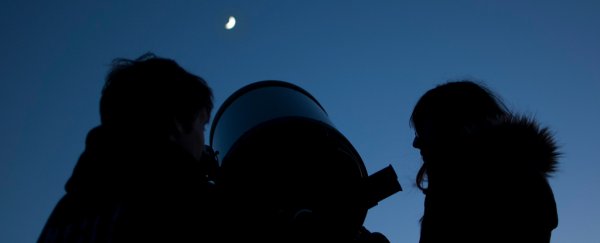This story was written by Bryonie Scott and originally published at The Conversation.
Clear skies this Australia Day could give observers a rare look at a giant asteroid flying past Earth at 56,000km/h. The asteroid, known as 2004 BL86, will not return to Earth for around another 200 years.
It was first discovered in 2004 by the Lincoln Near-Earth Asteroid Research (LINEAR) program, a joint venture between NASA and the Massachusetts Institute of Technology which searches for near-Earth objects.
The Australia Day asteroid is thought to be about 0.5 to 1 kilometre in diameter and is predicted to pass the Earth at a distance of 1.2 million kilometres – that's about three times the distance from the Earth to the Moon.
It will be the closest asteroid of this size to come past Earth until the predicted fly-by of another rock, called 1999 AN10, on August 7, 2027.
How can you see it?
To see 2004 BL86 this Australia Day NASA's advice is to use a telescope or a decent pair of binoculars.
On its closest approach, where it will be at its brightest, the best viewing will be done from the northern hemisphere.
For the southern hemisphere, it will be quite a bit fainter, but still possible to spot. You will need quite clear conditions, and not too much light pollution, so it's recommended to get out of any city if you can.

After sunset on January 26, at about 9pm, 2004 BL86 will be visible towards the east, near the constellation Hydra. At this point it will only be at visual magnitude 10.4. It will look like a very pale star.
Simon O'Toole, a research astronomer at the Australian Astronomical Observatory, says it will be moving quite slowly across the sky.
"When you do observe it, it's moving at about 1 degree per hour across the sky. That's about the width of the moon every 30 minutes or so," he says.
Throughout the evening it will track across the galactic plane and will still be viewable in the early hours of the next morning towards the north-west.
"For the really super keen who are still partying, at about 6am, it will be near the horizon, near the constellation Leo," says Alan Duffy, a research fellow and astrophysicist at Swinburne University.
At this time of the morning, it will also be near Jupiter, one of the brightest objects in the night sky.

If you don't have access to a telescope, there is a way to view it online. A Virtual Telescope will be tracking the asteroid's approach.

So what's the big deal?
Asteroids of this size are not a common event. While the Earth is bombarded with small meteorites on a daily basis, an asteroid of this size makes the LINEAR program take notice. The Minor Planet Centre keeps a running tally of all near-Earth objects.
"The idea that you can have something so large at such incredible speed, and if you didn't have NASA, you wouldn't even know it was there," says Dr Duffy.
NASA's Deep Space Network antenna at Goldstone, California, in the United States, and the Arecibo Observatory in Puerto Rico will be using radar to create detailed images of the asteroid as it flies so close past Earth.

Donna Burton, a PhD candidate at the University of Southern Queensland, says microwave and radar pulses will be sent out from these antennas in order to bounce off the object. The resulting echo that returns to Earth allows scientists to measure key aspects of the asteroid such as its distance, size, shape and density.
"This is a similar process to sonograms done under the sea to identify large items such as shipwrecks," says Ms Burton.
With more detailed information, NASA will be able to figure out a more accurate orbit for the asteroid, to determine whether it could be a potential threat in the future.
The albedo rating is a measure of the asteroid's reflectivity. The higher the albedo, the shinier the object.
Scientists will use this measure to look at what the asteroid is made of. If 2004 BL86 has a low albedo rating, it is more likely to be a rocky substance. If it has a high rating, it should have a more icy consistency.
Brad Carter, Associate Professor of Physics at the University of Southern Queensland, says asteroids are a great source of fascination for astronomers because they are like artifacts from history.
"They are primordial objects, rubble from the formation of the solar system," he says.
Life on Earth may have started from an asteroid such as this one. So it is important to learn as much as we can about these objects when we are given an opportunity such as this.
![]() Source: This article was originally published on The Conversation. Read the original article.
Source: This article was originally published on The Conversation. Read the original article.
